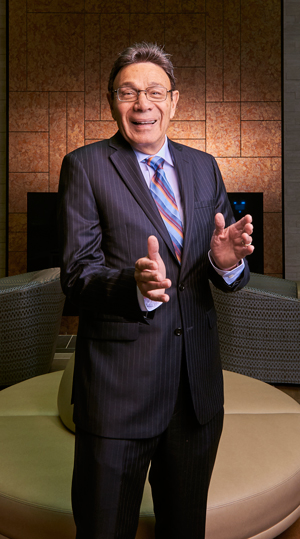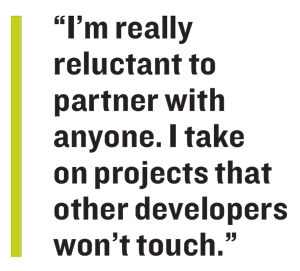Trending
Martin Ginsburg’s development game

Martin Ginsburg’s 56-year career as one of Westchester County’s premier developers began rather modestly, in 1963, when he and his brother Jerome bought a single lot in Greenburgh.
The Ginsburgs built and sold a house, then bought two more lots, then another five, then 25. Within a couple of years, their brother Sam came on board, and Martin quit his job designing hotels as an architect in New York City to become a full-time developer.
Jerome took off on his own in the 1980s, and Sam left in the 1990s, believing that Ginsburg Development Companies (GDC) was growing too quickly. Today, Martin, 84, is the sole principal of the company, where he is in charge of a team of 75 employees who do everything from architecture and design to construction and property management.
GDC has built more than 10,000 units of housing over the years, most of them condos. The Valhalla-based company’s work can be seen all over Westchester, and it has 1,361 units in its current rental portfolio. Several recently completed multifamily rental projects include River Tides and 1177 @Greystone, both in Yonkers, Harbor Square in Ossining, The Lofts on Saw Mill River in Hastings-on-Hudson and the Fort Hill Apartments at the Abbey Inn in Peekskill. New for-sale projects include the Gateway Townhomes in Peekskill and the Stone Hollow single-family home community in the Orange County town of Cornwall.
Right by the White Plains Metro-North train station, GDC is transforming the Westchester Financial Center into City Square. The mixed-use project includes the renovation of Class A office space, new restaurant and retail space and the conversion of an office building at 1 Martine Avenue into 188 rental units. The project will be the first development in White Plains’ new Transit District zone, an initiative created last year to encourage mixed-use development and pedestrian traffic.
Ginsburg, originally from the Bronx and now a Dobbs Ferry resident, spoke with The Real Deal about the current market, what sets his company apart from other developers and whether retirement plans are in his future.
Are you worried about an overall downturn in the market? We know that downturns come along. Am I worried? No. I don’t see any signs of it. The overall economy seems OK, and we happen to be, generally speaking, in a good part of the country, a good part of the state and a good part of the area [in Westchester]. Even with all of the craziness going on in Washington, we still have a good economy.
 Many developers are offering incentives to lure in renters and buyers. What are you offering? Very often we will offer one month’s rent for the initial lease, for 13 or 18 months. If the building has a spa, we may throw in some free massages.
Many developers are offering incentives to lure in renters and buyers. What are you offering? Very often we will offer one month’s rent for the initial lease, for 13 or 18 months. If the building has a spa, we may throw in some free massages.
Tell us more about your plans for the City Square project. We’re going to make that thing a tremendous gateway to White Plains. We’ll have retail, mostly restaurants, right on Main Street. I want to really make that special. We’ll have a unique Central Park there with a putting green, performance area, fountain and outdoor dining. We’re doing the Central Park area first. Once we get site plan approval for the exterior work, we hope to be under construction in June, and then have it done in six to eight months.The MTA is spending $92 million to renovate the White Plains train station, which is the busiest in Westchester. Is that why you decided to move forward on the City Square project? That was icing on the cake as far as we were concerned. I think we would have gone ahead with it anyway. It only enhances the development.
Do you ever partner with other developers? No. I worked with my brothers earlier. I won’t say never, but I’m really reluctant to partner with anyone. I take on projects that other developers won’t touch. Other developers start with the numbers and take it from there. I like to see what could work for a site, what the project could be and then look at the numbers.
How do you distinguish GDC from other developers? We don’t just do a project — we like to build communities. We spend a lot of money on things that don’t necessarily go to the bottom line. I do very well with empty nesters, but I like a diverse crowd. It makes it more like an urban community. We also do a lot of community activities. We like to say we’re creating a resort. We want to create a special place where people want to be year-round.
How does being an architect fit in with being a developer? I have my own architect’s office here. Of course, I hire other architects to do some of the work, but we do the architecture, we’re the designers. We direct the whole thing. We’re very hands-on and very fussy about finishing the project, including the landscaping, which everybody leaves out. We’re not just business people — we’re master planners and architects.
What is the rental occupancy rate for GDC’s portfolio? We’re in the mid-nineties for ones that have achieved occupancy.
What are typical rates for your apartments? For studios, we start at $1,900 and go up to $6,000 for large units with river views. For one-bedrooms, it would be $2,200 to over $3,000 for units with a study and a powder room. We probably average higher than most because we have larger units. If you’re downsizing from a big million-dollar home, you don’t want to live in a 750-square-foot apartment. We don’t have as many studios as a lot of other buildings.
I’ve read that you’re a big believer in staying fit and in good shape. Yes, it’s true. I do 300 sit-ups at a sitting several times a week. I’m a great believer in keeping the center part of your body strong because it helps your back. I used to have back problems — I don’t anymore. I also do tai chi, for balance. And I put my socks on standing up. Have you ever done that? And I wear tight socks.
Any plans to retire? No. I’ve got too many things to do.
This interview was condensed and edited for clarity.




